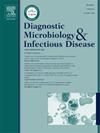The aetiologic agents and resistance rates in community-acquired complicated intra-abdominal infections: Where are we locally?
IF 1.8
4区 医学
Q3 INFECTIOUS DISEASES
Diagnostic microbiology and infectious disease
Pub Date : 2025-07-22
DOI:10.1016/j.diagmicrobio.2025.117023
引用次数: 0
Abstract
Background
Community-acquired complicated intra-abdominal infections (CA-cIAIs) are a significant global health concern, associated with considerable morbidity and mortality. In regions lacking local epidemiological data, obtaining intraoperative cultures is recommended to guide empirical antibiotic selection. This study aimed to describe the local microbiological profile and resistance patterns in CA-cIAIs.
Methods
We retrospectively reviewed adult patients operated for CA-cIAIs at Ankara University Hospital between January 2018 and December 2023. Inclusion criteria included intraoperative or percutaneous drainage sampling and absence of recent hospitalization or abdominal procedures within three months.
Results
Among 124 surgical patients, cultures were collected from 80 (64.5 %), with 44 (70 %) yielding microbiological growth. A total of 69 pathogens were identified. The most frequent infection sources were cholecystitis (36 %), appendicitis (27 %), and colon perforation (20 %). Escherichia coli (46.4 %), Klebsiella pneumoniae (10.1 %), and Enterococcus faecalis (8.7 %) were the predominant organisms. Extended-spectrum beta-lactamase (ESBL) production was observed in 30.4 % of Gram-negative strains, with notable resistance to third-generation cephalosporins (40 %) and fluoroquinolones (33.3 %). Empirical antibiotics included piperacillin-tazobactam (77.2 %) and teicoplanin (47.7 %). However, their predictive values were low (PPV: 32.4 % and 38.1 %, respectively), with moderate concordance rates.
Conclusions
E. coli remains the leading pathogen in CA-cIAIs, but rising resistance rates to key antibiotics pose challenges to empirical treatment. Although piperacillin-tazobactam and teicoplanin were the most commonly used empirical agents, their low PPV underscore the need for improved strategies to optimize empirical therapy. Our findings emphasize the importance of obtaining intraoperative cultures to enable timely de-escalation and appropriate antimicrobial stewardship

社区获得性复杂性腹腔感染的病原学因素和耐药率:我们在哪里?
社区获得性复杂性腹腔感染(CA-cIAIs)是一个重要的全球健康问题,与相当高的发病率和死亡率相关。在缺乏当地流行病学数据的地区,建议获得术中培养以指导经验性抗生素选择。本研究旨在描述CA-cIAIs的局部微生物特征和耐药模式。方法回顾性分析2018年1月至2023年12月在安卡拉大学医院接受CA-cIAIs手术的成人患者。纳入标准包括术中或经皮引流取样以及最近3个月内没有住院或腹部手术。结果124例手术患者中,有80例(64.5%)收集了培养物,有44例(70%)产生微生物生长。共鉴定出69种病原菌。最常见的感染源是胆囊炎(36%)、阑尾炎(27%)和结肠穿孔(20%)。优势菌为大肠杆菌(46.4%)、肺炎克雷伯菌(10.1%)和粪肠球菌(8.7%)。30.4%的革兰氏阴性菌株产生广谱β -内酰胺酶(ESBL),对第三代头孢菌素(40%)和氟喹诺酮类药物(33.3%)具有显著耐药性。经验性抗生素包括哌拉西林-他唑巴坦(77.2%)和替柯planin(47.7%)。但其预测价值较低(PPV分别为32.4%和38.1%),符合率中等。大肠杆菌仍然是CA-cIAIs的主要病原体,但对关键抗生素的耐药率上升对经验性治疗构成挑战。尽管哌拉西林-他唑巴坦和替柯planin是最常用的经验性药物,但它们的低PPV强调了改进策略以优化经验性治疗的必要性。我们的研究结果强调了获得术中培养的重要性,以便及时降级和适当的抗菌药物管理
本文章由计算机程序翻译,如有差异,请以英文原文为准。
求助全文
约1分钟内获得全文
求助全文
来源期刊
CiteScore
5.30
自引率
3.40%
发文量
149
审稿时长
56 days
期刊介绍:
Diagnostic Microbiology and Infectious Disease keeps you informed of the latest developments in clinical microbiology and the diagnosis and treatment of infectious diseases. Packed with rigorously peer-reviewed articles and studies in bacteriology, immunology, immunoserology, infectious diseases, mycology, parasitology, and virology, the journal examines new procedures, unusual cases, controversial issues, and important new literature. Diagnostic Microbiology and Infectious Disease distinguished independent editorial board, consisting of experts from many medical specialties, ensures you extensive and authoritative coverage.

 求助内容:
求助内容: 应助结果提醒方式:
应助结果提醒方式:


